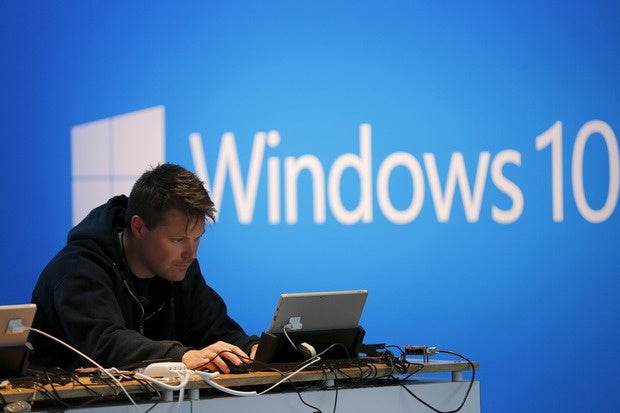Windows 10’s pushy upgrade tactics pay off with share growth

Microsoft’s recent campaign to force-feed the Windows 10 upgrade to older PCs appears to have been successful, generating a short but sustained increase in usage, according to a pair of data sources.
Last week, users of Windows 7 and Windows 8.1 systems began reporting that the automatically-downloaded Windows 10 upgrade had been installed, with an accompanying glut of complaints that they had not had the opportunity to decline the offer, or if they did see a way to reject 10, were stuck in a loop where the demand endlessly reappeared.

Analytics purchase decisions are littered with opportunities for missteps. These 10 questions will help
Read Now
In some cases, users were unable to regain control of their machines until they acquiesced and let Windows 10 install.
Although the automatic download of Windows 10 and its upgrading a PC from older OSes has been expected for months — and was switched on six weeks ago — the process was supposed to require user approval at some point. Yesterday, Microsoft again confirmed that, with a spokesman saying, “Customers continue to be fully in control of their devices” in a statement. Yet many users claimed that they had not been asked, and had, in fact, lost control of the procedure.
Whether such behavior was part of Microsoft’s plan or an error — either on Microsoft’s part or because of PC configurations — is unknown. Microsoft has declined to explain why Windows 10 had been installed without any user action.
The result was clearer.
According to analytics vendor StatCounter, Windows 10 posted substantial week-over-week increases in usage share starting March 10. In four of the next five days — through Monday, March 14 — those gains were near a full percentage point.
The last time StatCounter’s Windows 10 numbers increased that much during even a short stretch was at the end of 2015 and the first few days of 2016, when growth was likely buoyed by a combination of new PCs and the holidays. (Because Windows 10 has gotten only a minor foothold on business systems, when consumers are at their own PCs — on weekends but also on U.S. or global holidays — 10’s usage spikes.)
StatCounter measures operating system activity using page views from the websites belonging to its clients.
Another source of Windows 10 activity — the U.S. government’s Digital Analytics Program (DAP) — signaled a similar boost in the new OS’s usage.
DAP tallies visits to more than 4,000 websites on more than 400 domains maintained by U.S. government agencies, such as the Internal Revenue Service (IRS) and the U.S. Citizenship and Immigration Services (USCIS). The bulk of the traffic DAP measures originates within the U.S.
Like StatCounter, DAP showed that Windows 10’s share jumped beginning March 10, and maintained week-over-week increases of about a percentage point through yesterday. The gains were the largest and longest-sustained that DAP had measured since January 22-28.
 Sen. Durbin calls Abbott Labs’ IT layoffs ‘harsh and insensitive’
Sen. Durbin calls Abbott Labs’ IT layoffs ‘harsh and insensitive’ First look: The new iPhone 6S Plus impresses
First look: The new iPhone 6S Plus impresses ACLU: Orwellian Citizen Score, China’s credit score system, is a warning for…
ACLU: Orwellian Citizen Score, China’s credit score system, is a warning for…
On Sunday, March 13, for instance, Windows 10 accounted for almost a third of all Windows versions that powered PCs that were directed to a site among DAP’s collective. That was a record for Windows 10 in DAP’s tracking.
DAP’s Windows 10 data was analyzed by Computerworld as its portion of only Windows, and so was not identical to StatCounter’s, which was 10’s share of all personal computers.
Last week’s share surge was in contrast to February, when for the month as a whole Windows 10’s growth slowed to as little as half as much as the month prior.
Although some users faced with the take-it-or-take-it Windows 10 upgrade said that they’d retreated to an older OS — Windows 10 is supposed to let customers roll back to the previously-installed operating system for at least a month — the numbers from DAP and StatCounter hinted that many simply went with the flow and stayed with 10. But even some of those people were furious.
- Video/WebcastAdvanced IT Analytics: A Look at Real Adoptions in the Real World
- White PaperA Framework for Business Aligned Security Monitoring Use Cases
“Yesterday, I was shutting down my computer (previous Windows 7), and in the afternoon I checked my computer [and it] turned on with Windows 10,” wrote someone identified as MegamanEXE2013 on a Reddit thread Sunday. “Do I have a problem with the OS? No. Was it abusive? Yes, totally!”
Microsoft has crafted a Windows 10 upgrade strategy that has been much more aggressive than in the past, using a wide range of practices, from making the upgrade free to consumers and many small businesses, to loading the upgrade bits on PCs without waiting for customers to request them. Microsoft is determined to accelerate the uptake of Windows 10, and has set itself the goal of putting the operating system on 1 billion devices by mid-2018 to stress that fact.
The Redmond, Wash. company will continue to give away the Windows 10 upgrade to people running the consumer and mid-level commercial editions of Windows 7 and Windows 8.1 until nearly the end of July. It’s unclear what the firm will do then if it believes it has not convinced or cajoled enough users into upgrading. Among its options: extend the free deal or again change how it delivers and installs the OS on current systems.

[Source:- Computerworld]



